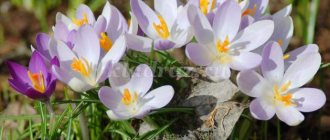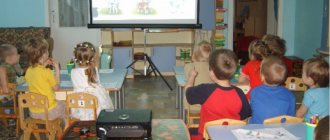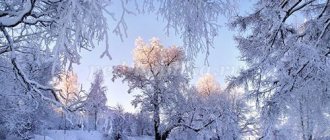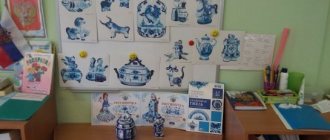Conversation about the forest in the preparatory group
Summary of a conversation about the forest for children 5-7 years old “A Journey through the Rooms of a Green House”
Author: Alevtina Germanovna Korobkina, teacher of the preschool educational institution “Smile” kindergarten, Perm region, urban settlement Suksun. Description: This material can be used by educators, counselors and primary school teachers, as well as parents in environmental education. Goal: to continue to form an understanding of the forest and the forester profession. Objectives: Educational.
Contribute to: clarifying and systematizing ideas about the forest and the forester profession;
strengthening cognitive interest and love for nature; aesthetic perception of the beauty of nature, through reproductions of paintings; Developmental.
Promote: the development of coherent speech, the ability to maintain a conversation, answer questions with complete answers;
developing respect for the work activity of a person in the forester profession; development of thinking, attention, memory. Educational.
Promote: nurturing love and respect for nature.
Material: reproductions of paintings by artists: Shishkin “In the Forest of Countess Mordvinova”, Shishkin “Ship Grove”, Levitan “Birch Grove” Illustrations on the topic phonogram “Sounds of the Forest” basket of hazelnuts Preliminary work: reading natural history literature to children, looking at reproductions of paintings by artists about nature , reading and memorizing poems on an environmental theme, excursions to the park, pine forest. Organization: children stand in a circle, holding hands. Round dance game “Let's go through the raspberries into the forest” 1. Let's go through the raspberries into the forest, let's go into the forest into the forest (children walk in a circle). Let's start a dance, let's start, let's start (one by one they put their legs out) Chorus: The sun is in the yard (hands are raised up, fingers are open - “sun”) And in the forest there is a path (palms folded together perform wave-like movements in front of you) My sweet you, raspberry ( sliding movements of the palms - the “Skeet” movement) 2. You, raspberry, not in the mouth, not in the mouth, not in the mouth (pinch grip of three fingers of the leading hand, move towards the mouth) Pour into the box, box, box. (a pinch grip of three fingers of the leading hand imitates picking berries into a basket, in front of the chest. Chorus: the movements are the same 3. Like picking, picking, picking raspberries. (a pinch grip of three fingers of the leading hand imitates picking berries from the ground - with the body tilted) We will bake pies, let's bake, let's bake ("pies" movement). Chorus: the movements are the same. 4. We'll bake, bake, bake pies. ("pies" movement). We'll call all the neighbors, we'll call, we'll call (movement of the hands, palms facing the face - “invitation”) Chorus: the movements are the same.
PROGRESS OF THE CONVERSATION.
Educator: What are we up to today? Children: will go on a journey through different rooms. Educator: which rooms can you travel through? Children's answers Educator: the riddle that the poet Jovan Jovanovic came up with will help us - Zmaj, listen carefully! I want to invite us to one beautiful village. He was quite lucky, who was able to visit the din. There, every house and every yard is covered with a green roof, a carpet woven with flowers lies on the street. There are no fences or doors. The windows are open to the garden. Guests will be greeted there with songs and treated to great pleasure. Those who were lucky enough to be there saw miracles! And the unusual village is called... Children: Green Forest Teacher: how did you guess that the riddle is about a forest? The children are talking. Educator: Yes, our journey to the big green house and through its rooms.
Educator: remember what riddle Dunno told us this morning? Zhenya came first today and can repeat, let’s all listen carefully to Zhenya. Zhenya: “a multi-storey building that was not built by a person. With invisible walls and an invisible ceiling. This house has very different apartments. The upper floors are bright and dry. The lower floors are dark and damp. The house has warm apartments in which you can live all year round. There are cold apartments in which you can only live in summer or spring.” Author of the riddle: Ivanova Valentina Tarasovna Educator: why can you call a forest home?! Children: home, because plants and animals cannot live without each other. Educator: Do you know such residents who cannot live without each other in the forest? Children: express and prove their versions, lay out pictures of forest inhabitants connected to each other.
Educator: what are these invisible walls in this house that was not built by man? Children: you can walk through the forest and see different things, there are no walls, but still different. Educator: yes, the forest is very different! The pine trees rustle with dry lingonberry leaves.
Educator: where were we?
Children: In a pine forest. Educator: a pine forest is also called BOR. Let's go further and see an emerald carpet of blueberries.
Now which forest did you enter?
Children: to the coniferous forest. Educator: The coniferous forest is also called BOR. We moved to another room. Did you see the wall? Children: no, we moved from a pine forest to a spruce forest. Educator: yes, different rooms, different forests. Let's move on. The thicket of bushes is impassable. What is that growing there?
Children: raspberries Teacher: let's go further through the forest. We reached the swamp.
The forest has become sparse. We passed the swamp. And suddenly it became light all around. What forest pleases with light and whiteness?
ISAAC ILYICH LEVITAN “BIRCH GROVE” Children: birch forest Teacher: can you name the residents? Children name the forest inhabitants . Teacher: what kind of forest does the brown BEAR like? Children: where there are a lot of berries and a river. Educator: the bear is a predator, but if you eat plant foods, you can do without meat. He’ll catch a fish in the river, that’s enough for him. Because what is it called? Children: omnivore. Educator: well, where does the FOX like to live?
Children: in a hole, digs a hole among the roots. Educator: what are these invisible ceilings, why does the riddle say so?
Educator: what is the first floor? Children: roots underground, mice live, moles. Educator: who lives higher? Children: cuckoos live in the bushes and make nests. And the woodpecker is hollowing out the hollow even higher. A squirrel can make a hollow even higher than a woodpecker. Birds that like to be closer to the sky go higher. Educator: yes, falcon families. Which apartments are dry and bright? Children: those in the trees, squirrels and birds. Educator: Which ones are busy all year round? Children: in the summer, because many birds fly to warm countries for the winter. Educator: who has dark apartments? Bears, foxes, badgers, hedgehogs have children Educator: who guards the forest? Children: forester. Educator: forester, forester, forester. She comes from ancient professions; forests have been protected in Rus' for a long time. More than 150 years ago, a forestry institute was opened in St. Petersburg. Now it is the Forestry Academy, University or Institute
Here in the Urals, the Forestry Engineering University trains foresters who grow forests in all corners of Russia. So, why did people come up with the profession of forest rangers if the forest grows on its own without humans? We will find out if we go to the forestry university and become students of this university
CHILDREN SIT ON CHAIRS, IMITATING A UNIVERSITY AUDIENCE. Educator: Why does a forester guard the forest, and here’s why. What if there's a forest fire? What if a bad man comes with an ax? What if a harmful caterpillar or bug appears? So goodbye forest! And to prevent this from happening at the cordon, the forester goes around. He walks around the forest and is the first to see if a bark beetle appears.
The bark beetle is small, but can eat a large forest. There are so many beetles that they sit on every tree, they sit on every twig, gnawing and sharpening. You can't remove them with your hands. And then the forester calls for help. A plane will fly in and scatter yellow poisonous powder. The bark beetle runs in, but there is no escape, no escape. Educator: So why create a cordon? Children's answers Teacher: if you cut down a forest, then only old trees, and don't touch young trees, then there will be no harm. So they SWEEP the forest, they whip it - that means they are cutting down big old trees. The timber is transported by trucks - timber trucks.
Timber trucks transport long trees with chopped off branches - they are called WHIP. They cut down trees with saws.
When the whips are removed, in the large clearing where very old trees used to grow, only stumps remain. Educator: So, what trees do lumberjacks cut in the forest? Children's answers Teacher: so, how then is the forest restored? Who is planting it? Children: probably the forester? Educator: to confidently answer my question, listen further. And at the cordon - a forest post - near the forester's hut - there are beds! But it’s not tomatoes or cucumbers that grow in the beds. MIRACLE
small, fluffy Christmas trees are growing! When it’s hot, they are watered, and the soil around them is also loosened with a rake. Everything is like in a garden. The soil of the Christmas trees in the beds is black. And the pines have sand. Who loves what! In the spring of this forest nursery, seedlings - very young pines and fir trees - will be brought to the cutting site. Here they will be planted and a new forest will grow.
Educator: Why will the seedlings be brought to the cutting area? Children: because old trees were cut down there. Educator: And in seventy years he will become an adult. Fast or long? Here you are 6, and now you are 7 years old. On the Christmas tree, its age can be easily counted by the rows of paws, as if by steps. Or you can recognize it by the rings on the trunk of a cut tree.
So the most amazing thing is that one person will plant it, and people of another generation will use this tree; probably, it will be possible to say about them that these are the children of your future grandchildren or even great-grandchildren?! The tree grows very slowly. So who knows the GROWTH of the forest?! Children: FORESTRY. Educator : our journey is coming to an end, let's remember the poem by the poet Alexei Koltsov “The Forester's House.” To the soundtrack “Sounds of the Forest,” children recite the poem line by line. In a dark forest, across the river, there is a small house, With two bright windows, With swing gates. That gate is under the castle, And the gate is locked, So that the horned Leshy, terrible and shaggy, does not enter there; So that a ghoul does not enter there, nor a passing hero, who lives here alone, far from housing around? Is the fisherman not rich? Or is there a bearded robber who is saved by prayer with chests and treasury? He has lived in the house for a long time - The forest elder and his wife are on guard in the royal forest. The third daughter is young. Conclusion. Educator: we have returned from a trip through the forest rooms. What did you like best about the trip? Children's answer Teacher: what new did you learn? Children's answer Teacher: the forester handed you a treat, what do you think it could be? Children's answer Teacher: a basket of hazelnuts. Educator: is the forester alone protecting the forest? Children name people of different professions who help the forester. Thank you for your attention!
We recommend watching:
Scenario of summer entertainment for children of the senior preparatory group of a preschool educational institution. Entertainment in the preparatory group. Scenario Conversation with children in the preparatory group on the topic: Wildflowers Summary of summer sports activities in kindergarten for older preschoolers
Similar articles:
Dramatization of Chukovsky's fairy tale The Fly Tsokotukha for children 5-7 years old
Scenario for summer entertainment on ecology at a preschool educational institution. Senior – preparatory group
Disco in kindergarten. Scenario
Game entertainment for children of senior preschool age in kindergarten
Forest is the quality of the environment
The forest is, first of all, the source of life for all life on Earth. It is not for nothing that it is called the “lungs” of the Earth. The forest is the main producer of oxygen and consumer of carbon dioxide. Therefore, the forest is, first of all, health. Among the forests, children's camps, holiday homes, and sanatoriums are most often built.
The forest is the protector of neighboring fields and meadows. As a green wall, it stands in the way of evil winds - dry winds and preserves the harvest. Forest birds protect meadows and fields from insects. And in winter, the forest, reducing the speed of the wind, prevents it from blowing away the snow blanket from the fields, under which it is warm for the grain seeds sown in the fall.
The forest stores large reserves of water that feed rivers, streams, and forest lakes. In spring, the snow in the forests melts slowly, and meltwater gradually replenishes nearby reservoirs. The forest protects the soil from winds and water flows, which quickly carry away the top fertile layer.
The forest is our resource storehouse
Without forests, economic activity is impossible. Therefore, the forest is a source of many materials. Forest is used in various sectors of the national economy. It serves as a source of chemicals obtained from the processing of wood, bark, and pine needles. The forest supplies raw materials for the production of over 20 thousand products and products.
Fig. 3 Scheme of wood use during its processing
The forest is a source of medicinal herbs and products. People collect medicinal plants in the forest. Vitamin supplements are obtained from pine needles. Man harvests nuts, mushrooms, and berries in the forests.
The forest is also a social role
The forest influences the way of life of entire peoples living nearby. Our people are also connected with the forest. In fairy tales and ancient legends, the main place is given to the forest and its inhabitants.
Forests have long been places for people to walk and relax. And even in our time, a city dweller in the summer cannot imagine himself without relaxing in the cool shade of trees. And in winter the forest calls for a ski trip. In spring and summer, the forest attracts people with flowering plants, and in the fall with its gifts: mushrooms, berries, nuts.
The forest is beautiful and unique at any time of the year. Poets, writers and musicians describe and glorify its beauty. Every person who has been in the forest enjoys admiring the wonderful forest landscapes.
General characteristics of the territory of the Dyatkovo forestry
In preparation for the project, my mother and I went to the Dyatkovskoe forestry. There we met with assistant forester Natalya Vasilievna Ushatkina and acting director Nikolai Vasilievich Znamenkin. From a conversation with them, we learned a lot of interesting and useful information about our forest and the organization dealing with forests in the Dyatkovo region.
The state government institution Dyatkovo forestry is an organization dealing with forests in the Dyatkovo district. That's what it's called now. From 1993 to 2007, the organization was called Dyatkovo forestry enterprise. The staff is not very large. It is headed by the director of the forestry, at the moment he has not been appointed and his duties are performed by deputy director Nikolai Vasilievich Znamenkin.
Today, Dyatkovskoe forestry is a forest area, which includes 106 thousand hectares. Structurally, Dyatkovo forestry consists of 5 district forestries. Since 2007, the Dyatkovo forestry has been performing the function of supervision and control in forest areas, providing protection from forest violations and forest fires during the fire hazard period. The main document of forest legislation is the Forest Code of the Russian Federation.
Work on protection and supervision in forest areas is carried out by state forest inspectors. The district forester supervises everything.
There are 9 tenants working on the forest plots. About 75% of forest areas are leased. Six tenants are involved in timber harvesting. They carry out mainly sanitary felling and thinning - this accounts for 98% of the total area.
There are two tenants who use the plots not for timber harvesting, but for mining. This is the Maltsovsky quarry management, which rents areas on the territory of our forest areas for the extraction of chalk and marl, which are used for the production of cement. Also among the tenants is the Fokinsky Construction Materials Plant. He also rents forest plots on the territory of the forestry for the extraction of green clay and chalk, for the production of red bricks.
There is also a tenant who rents an area of 9.3 thousand hectares for the purpose of hunting. A road network for patrolling has been created there, there are feeding troughs, salt licks for animals, protection against poaching is carried out, and the numbers and reproduction of game flora and fauna are monitored there. Among the hunting animals found there are: wild boar, elk, hare, raccoon dog, squirrel, fox. Birds include black grouse, wood grouse, hazel grouse, and partridge.
The forestry exercises control over the tenants so that they do not violate forest legislation, accepts all work (how they cut, how they hand over the cutting areas after felling), all cutting areas are subject to new planting. Tenants are engaged in forest restoration. They grow some of the seedlings on their premises. In particular, Dyatkovo-DOZ has greenhouses for growing young animals - about 300 thousand seedlings; the tenants purchase the missing amount of planting material in Belarus.
Last year, 350 hectares were planted. This year there are 390 hectares of young animals. And 300 hectares are planned to be planted next year. Every year, for the last 7-8 years, about one and a half million seedlings are planted.
Areas where reforestation cannot be carried out (wetlands, areas with many uneven terrain) are left for natural regeneration. First, coppice species appear there, such as aspens, birches, a certain amount of pine and spruce, and oaks always appear. Their seeds are distributed by jay birds.
With the onset of the fire danger period, measures are taken to protect the forest from fires, these include: the organization of mineralized strips, they prevent the spread of fire; hanging fire safety-themed signs. The most visited places in the forest zone are equipped with resting places (forest furniture: benches, tables).
The areas of our forestry are represented by a tree stand that is not very susceptible to burning; we have a predominance of soft-leaved species. The plantings consist of approximately 50% birch, 20% aspen, 20% spruce, 10% pine, 2-3% oak and linden.
In 2010, there were 10 forest fires on an area of 8.9 hectares. In 2012 there was one case, in 2014 there were 4 cases of fire on an area of 5 hectares, and this year there were 2 forest fires on an area of 5.5 hectares. They did not cause much damage, as they were localized in time.
In 1999, the typograph bark beetle appeared in our forests. It spreads very quickly and causes great damage to forest plantations. This beetle is described in detail in the article “Biology of the forest pest bark beetle and measures to combat it” published in our local newspaper “Plamya Truda” in April 2015.
How does forest damage occur?
Forest fires have a great negative impact on many forest life processes.
During forest fires, the growing forest is damaged or completely destroyed, along with the undergrowth, regrowth and grass cover. Fires destroy bird nests and animal habitats and promote the proliferation of harmful insects. Forests are damaged by tourists (they damage trees, bushes, grass) and cars. Mechanical impact causes soil compaction and damages forest grasses. With soil compaction, tree nutrition deteriorates. Deterioration of nutrition weakens trees, retards their growth and development. First of all, the soil cover and young trees begin to suffer.
Picking mushrooms, flowers and berries undermines the self-renewal of a number of plant species.
A fire completely disables the piece of land on which it was laid out for 5-7 years.
The noise scares away birds and mammals and prevents them from raising their offspring normally.
Breaking branches, nicks on trunks and other mechanical damage contribute to the infestation of trees by insect pests.
Fungal pests cause enormous damage to forests. If the fruiting body of a fungus grows on the trunk, the tree is sick. And infection begins with a trifle. Children or adults walking through the forest will break a branch or inflict a wound with a knife, sometimes animals will gnaw off the bark. Fungal spores in the air get into such a wound. As the fungus develops, it begins to destroy the tree from the inside and, over time, forms a hollow.
Cattle grazing. During grazing, young trees die, which are eaten and trampled by livestock.
Littering forests with wood debris during timber harvesting causes great harm to forest ecosystems. Heaps of branches, bark, and tall stumps become breeding grounds for forest pests.
Household garbage left in the forest by vacationers, tourists, or dumped from cars worsens the aesthetic appearance of the forest, and if it is heavily cluttered, it contributes to the replacement of forest grasses by plants of garbage habitats - ruderals (primarily nettles and celandine).







